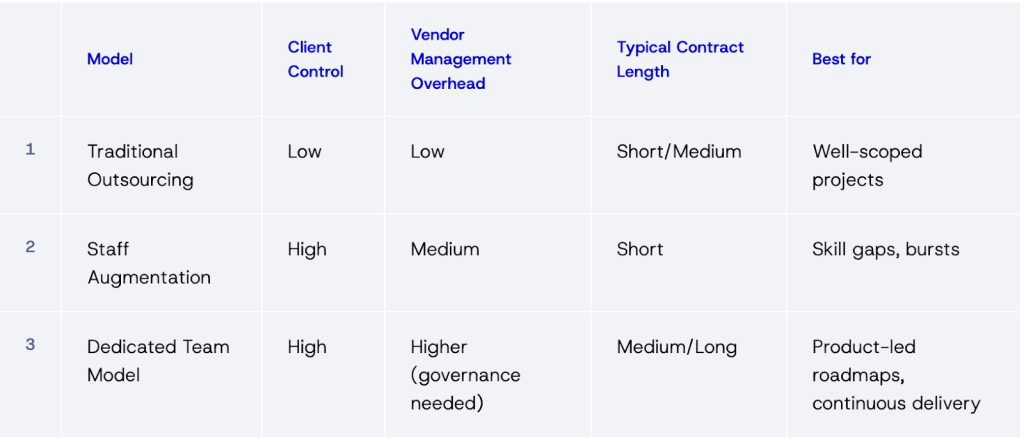Why the Dedicated Team Model Is Replacing Traditional Outsourcing

How modern sourcing models favour continuity, speed and product-ownership over defined projects
Introduction
In a rapidly changing software-and-services market, many companies no longer see traditional outsourcing as the default. Rather than handing off a fixed-scope project and hoping for the best, more businesses are opting for a “dedicated team” model — a long-term embedded team, aligned with the client’s product roadmap, culture and practices.
Why? Because product development is less about “deliver this module” and more about “continuously innovate, pivot, scale”. That demands a sourcing model built for change, collaboration and long-term value — and that’s where dedicated teams win.
In the Deloitte 2024 Global Outsourcing Survey, for instance, the idea of “multidimensional sourcing” is front and centre: organizations are rethinking how they access talent and deliver outcomes.
In the sections below we’ll define the models, explore the trend-drivers, weigh the pros & cons, and provide a decision framework for when a dedicated team makes sense.
1. Defining the Models
To compare meaningfully, let’s define three common sourcing models:
- Traditional Outsourcing (Project/Outcome-based)
A vendor engages under a fixed-price or T&M contract, accountable for defined deliverables (for example: “build the migration”, “deliver the mobile app”). The vendor owns process, execution and often some risk. The client sets requirements and receives the completed work. - Staff Augmentation (Individual Contractor or Specialist)
The client engages individual specialists via a vendor (or directly) to plug into their team. The specialists are managed by the client’s PM/engineering lead, for a defined time period or scope. Good for short-term skill gaps. - Dedicated Team Model (Team Extension / Outstaff / Long-Term Pod)
The vendor provides a full or partial team (developers, QA, maybe UX/design) which becomes embedded in the client’s organisation, follows the client’s backlog, functions as part of the client’s delivery pipeline, and is managed (day-to-day) by the client’s internal lead. The engagement tends to be long-term and flexible (you can scale up/down, shift priorities).
In short: the dedicated team model shifts from “vendor delivers outcome” to “team works as extension of client’s team”.
Comparison summary (example table):2. Market Trends: Why the Shift Is Happening

Several forces are pushing companies from traditional outsourcing toward dedicated teams:
- Talent scarcity & velocity demands. According to the Clutch “State of Software Development” report, 87% of companies say they currently feel or will soon feel the impact of talent gaps. When hiring full-in-house is slow and costly, and when time-to-market counts, embedding dedicated teams gives a middle path.
- Need for continuity & product ownership. The software world is less about one-off builds and more about continuous evolution. Dedicated teams preserve product knowledge, avoid hand-off losses, and maintain velocity.
- Increased complexity of sourcing ecosystems. The Deloitte 2024 survey highlights that 70% of executives have insourced work previously outsourced, and 78% use global in-house centres (GICs). It’s a shift toward layered sourcing — where dedicated teams are one layer.
- Rise of flexible, outcome-oriented delivery. According to Gartner (in their “Top 10 Strategic Technology Trends for 2024”), models like the “Augmented Connected Workforce” are gaining ground, meaning organisations expect more from their external teams than just head-count—they expect integration, agility and alignment.
These trends together make traditional outsourcing less attractive for companies that need speed, alignment and continuous delivery.
3. Pros & Cons of Each Model
Here’s a breakdown of each model’s strengths and trade-offs.
Traditional Outsourcing
Pros:
- Clear outcomes and contract-based accountability.
- Lower management overhead for the client (vendor handles a lot).
- Suitable when scope is well defined and unlikely to change.
Cons:
- Weak fit when scope changes or the product evolves.
- Less knowledge transfer to the client organisation (vendor owns process).
- Often slower feedback loops and less embedded alignment with client’s culture.
Ideal for: one-off projects, legacy migrations, non-core service delivery.
Staff Augmentation
Pros:
- Fast injection of skills; flexible head-count.
- Client retains control of backlog and priorities.
- Good for bridging short-term skill gaps.
Cons:
- Client retains full management responsibility for the augmented staff.
- Less team cohesion (contractors may behave differently).
- Risk of weak ownership of outcomes (contractors may feel “external”).
Ideal for: temporary scaling up, niche/urgent skills, short tasks.
Dedicated Team Model
Pros:
- Strong alignment with client’s product, culture and roadmap.
- Knowledge continuity: team stays over long-term, reducing ramp-ups.
- Flexibility to scale and pivot: the team is embedded, so priorities adjust.
- Often leads to higher productivity, stronger collaboration, faster feature cycles.
Cons:
- Requires stronger vendor governance (onboarding, integration, process alignment).
- Client needs to commit to managing the team (PM, backlog management, integration).
- If not scoped well, risk of vendor lock-in or difficulty transitioning.
- Legal/contractual complexity (IP, exit clauses, HR/contract terms) may be higher.
Ideal for: companies with ongoing product development, long roadmaps, cultural fit with vendor, need for speed and continuity.
4. When to Hire a Dedicated Team – Decision Framework
Here’s a pragmatic framework to assess which model fits best. Score each question 0–3 (0 = low/short, 3 = high/long):
- Time horizon of work — short (0), medium (1), long (>12 months) (3)
- Need for product ownership and continuity — low to high
- Skill availability internally — abundant (0) vs scarce (3)
- Rate of change in requirements — stable (0) vs dynamic/pivots (3)
- Budget model flexibility — fixed only (0) vs flexible monthly (3)
Interpretation:
- Score 8+ → Strong signal for the Dedicated Team Model
- Score 4–7 → Consider Staff Augmentation or a Hybrid approach
- Score <4 → Traditional Outsourcing likely more appropriate
Buyer profiles:
- A start-up scaling its SaaS product rapidly: Dedicated Team is ideal (high horizon, high continuity, scarce internal skills).
- A large enterprise executing a defined migration project: Traditional Outsourcing fits (short horizon, defined scope).
- A company needing periodic specialist boost (e.g., Data Science work for 6 months): Staff Augmentation fits.
Red flags before choosing dedicated team:
- No clear product owner or backlog owner on client side
- No budget commitment beyond short term (<6 months)
- Client unwilling to integrate vendor team as part of own organisation
5. Governance & Contract Checklist for a Dedicated Team
To succeed with a dedicated team, you need strong governance and contract clarity. Key elements:
Operational Onboarding:
- Joint onboarding plan (first 30-60 days) including pair-programming, culture orientation, shared tools.
- Single, unified backlog and sprint cadence integration (vendor team sits in your sprint reviews).
- Access & security setup (least-privilege access, SSO, audit logs) from day one.
Contractual & Legal:
- Clear IP ownership clauses (code, documentation, product assets).
- Term & notice periods, exit/knowledge-transfer clauses (so you avoid loss if vendor changes).
- SLAs for availability, quality, but also KPIs for productivity (e.g., features delivered/month, defect rate).
- Scaling flexibility: ability to add/remove resources month-to-month without expensive renegotiation.
- Governance forums: weekly demos, monthly steering, quarterly roadmap sync.
Putting these in place transforms the dedicated-team model from “vendor block” into a true extension of your organisation.
6. Evidence & Statistics
Here are some key data-points you can highlight:
- In the Deloitte 2024 Global Outsourcing Survey: 70% of executives say they have insourced scope that was previously outsourced in the last 5 years.
- The same Deloitte report: 80% of executives are planning to maintain or increase investment in third-party outsourcing.
- The Clutch “State of Software Development” report: 87% of companies say they already feel or expect to feel the impact of talent shortages.
- Gartner’s “Top 10 Strategic Technology Trends for 2024” includes “Augmented Connected Workforce” — signalling that flexible sourcing models and embedded teams are strategic.
- According to Deloitte: 83% of organisations are leveraging AI as part of their outsourced services, yet only 25% report cost reductions or improved quality to date — illustrating that sourcing models must adapt.
These data validate that companies are shifting sourcing models, looking beyond cost, and prioritising alignment, continuity, speed and talent.
7. Case Studies (Short Illustrations)
Case A: SaaS Scale-Up (Berlin)
A Germany-based SaaS company had a roadmap of features for the next 18 months but their internal team was small. They switched from repeated outsourcing of discrete modules to a 6-person dedicated team embedded with their product lead. Outcome: time-to-first new feature dropped by ~35%, ramp-up cost decreased because the team stayed on and developed product context.
Case B: Financial Services Firm (Paris)
A French financial services firm used traditional outsourcing for a data migration project (6 months) but retained a dedicated extension team for ongoing feature development and compliance modules. The result: faster compliance release cycles, better alignment with internal product strategy and fewer hand-offs.
8. Practical Next Steps
If you’re a product lead or CTO reading this, here’s what to do next:
- Map your current and upcoming work by horizon, complexity and internal vs external ownership.
- Run a 30-day pilot of a dedicated team (3-4 months) with defined onboarding, KPIs and exit clauses.
- Build your sourcing governance playbook: vendor selection criteria, integration process, backlog ownership model.
- Measure: defects, delivery speed, ramp-up time, team retention — compare the traditional model vs the dedicated team over 3–6 months.
Conclusion
The dedicated team model is replacing traditional outsourcing not because cost disappears, but because value is shifting: from cheap deliverables to embedded velocity, aligned culture and continuous outcomes.
In today’s digital world, speed matters, but alignment matters more. If you’re building a product, iterating fast, and need a partner who behaves like an extension of you — not just a vendor — then the dedicated team model is likely your next step.





